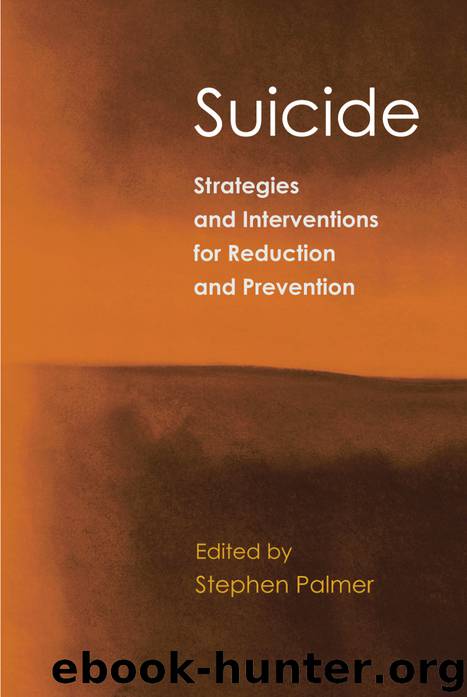Suicide by Unknown

Author:Unknown
Language: eng
Format: epub
ISBN: 978-1-317-82195-3
Publisher: Taylor and Francis
The reactions of therapists to a client’s suicide
Therapists work with suicidal clients almost every day of their lives. However, when one of these clients commits suicide, how is the therapist affected?
Litman (1965) notes that psychotherapists tend to be philosophical about death and have tranquil attitudes and yet the same person might describe a quite different emotional experience after a direct encounter with death as an actual event. He reported observations from interviews with more than 200 therapists. His first observation was how hard it was to elicit therapists’ attitudes and reactions to the death of their client through suicide: therapists were either philosophical, casual and flippant or introduced ethics as reasons for not speaking about it. Litman (1965) states that
according to my observations therapists react to the death of a patient, personally, as human beings, in much the same way as do other people. They react, secondly, in accordance with their special role in society. Their theoretical, philosophical, and scientific attitudes serve as a defensive and reparative function, being used to overcome the pain which they feel as human beings and as therapists.
(Litman, 1965, p. 572)
In addition Litman (1965) states that personal reactions depend on a variety of factors such as how the therapists viewed the client, how long and how close as well as the degree of professional commitment. However, therapists have described their first experience as the worst, where lack of confidence, intense sadness and shock are experienced. He likened the guilt experienced by therapists as an exact replica of guilt experienced by relatives of person who committed suicide as well as feelings such as anger and pain. Litman (1965), from his observations, suggests that the psychological mechanisms that are universal in relatives and therapists were denial and repression. He notes that therapists’ reactions (as therapists) emphasized fears concerning blame, responsibility and inadequacy and were sometimes marked and exposed. Therapists also described high anxiety when working with suicidal clients after they experienced the death of a client and a number reported that they no longer worked with suicidal clients.
Litman (1965) suggests that a supportive environment, presentation of cases and a feeling of shared responsibility tend to help therapists work through their grief. However, he does not observe any change in general attitudes towards suicide but found that therapists said they tried to use their experience to broaden their horizon, become a person who is more sensitive and with improved professional judgements and actions. Litman (1965) endorses this view and cautions therapists to be aware that if part of the pain is repressed, it does return later. He encourages therapists to work through the traumatic incident so that a personal change and a professional broadening can be manifested.
Similarly, Levinson (1972) describes the necessity and difficulty in mourning the loss of a client through suicide, and notes how aggression towards the deceased can interfere in the satisfactory working through of the loss. Alexander (1977) reiterates this theme. He describes his own experiences and states that aggression in the pre-loss relationship to the client, if not recognized, can complicate the therapist’s mourning for the patient.
Download
This site does not store any files on its server. We only index and link to content provided by other sites. Please contact the content providers to delete copyright contents if any and email us, we'll remove relevant links or contents immediately.
Mindhunter: Inside the FBI's Elite Serial Crime Unit by John E. Douglas & Mark Olshaker(9106)
Wiseguy by Nicholas Pileggi(5609)
Hitman by Howie Carr(4978)
Room 212 by Kate Stewart(4963)
Secrecy World by Jake Bernstein(4594)
Killers of the Flower Moon: The Osage Murders and the Birth of the FBI by David Grann(4348)
Papillon (English) by Henri Charrière(4146)
Breaking Free by Rachel Jeffs(4116)
Killers of the Flower Moon by David Grann(3902)
Say Nothing by Patrick Radden Keefe(3845)
American Kingpin by Nick Bilton(3711)
The Secret Barrister by The Secret Barrister(3561)
Molly's Game: From Hollywood's Elite to Wall Street's Billionaire Boys Club, My High-Stakes Adventure in the World of Underground Poker by Molly Bloom(3442)
Mysteries by Colin Wilson(3363)
In Cold Blood by Truman Capote(3269)
Signature in the Cell: DNA and the Evidence for Intelligent Design by Stephen C. Meyer(2996)
I'll Be Gone in the Dark by Michelle McNamara(2986)
Rogue Trader by Leeson Nick(2945)
Bunk by Kevin Young(2900)
